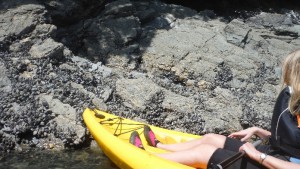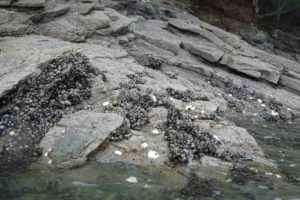Low Tide on the Helford
At low tide, the creeks of the Helford seem to become land again. The water recedes, revealing rich, moist mud—alive with fish and invertebrates—which draws in wading birds like herons and little egrets, who take full advantage of this feeding ground.
On the exposed Devonian slate, a hidden world emerges. Fish dart across shallow pools, and the muddy banks become a buffet for birds and foragers alike.

Limpits and Breadcrumb Sponge
You might spot Helford Mussels, traditionally only harvested on Good Friday, clinging tightly to rocks. Or perhaps the small, flat-shelled Helford Oysters, prized for their subtle flavour.

Mussels and Oysters

Mussels and Oysters
Among them, you’ll also find the last remnants of the Pacific Oysters—larger and rugged with sharp shells. These aren’t your pearl-producing oysters; they were grown in a lab in the Channel Islands before being brought to the Helford to mature in its nutrient-rich waters.
Then there’s the Helford Scallop, hiding in the silt, and a variety of edible seaweeds. One of the most curious is sugar kelp, which, when it dries, leaves behind a sweet-tasting white powder—nature’s own coastal candy.

Breadcrumb sponge
Look closely and you may even spot the breadcrumb sponge—a vivid orange sea sponge that clings to the rocks, a delicate and beautiful resident of this unique estuarine ecosystem.











